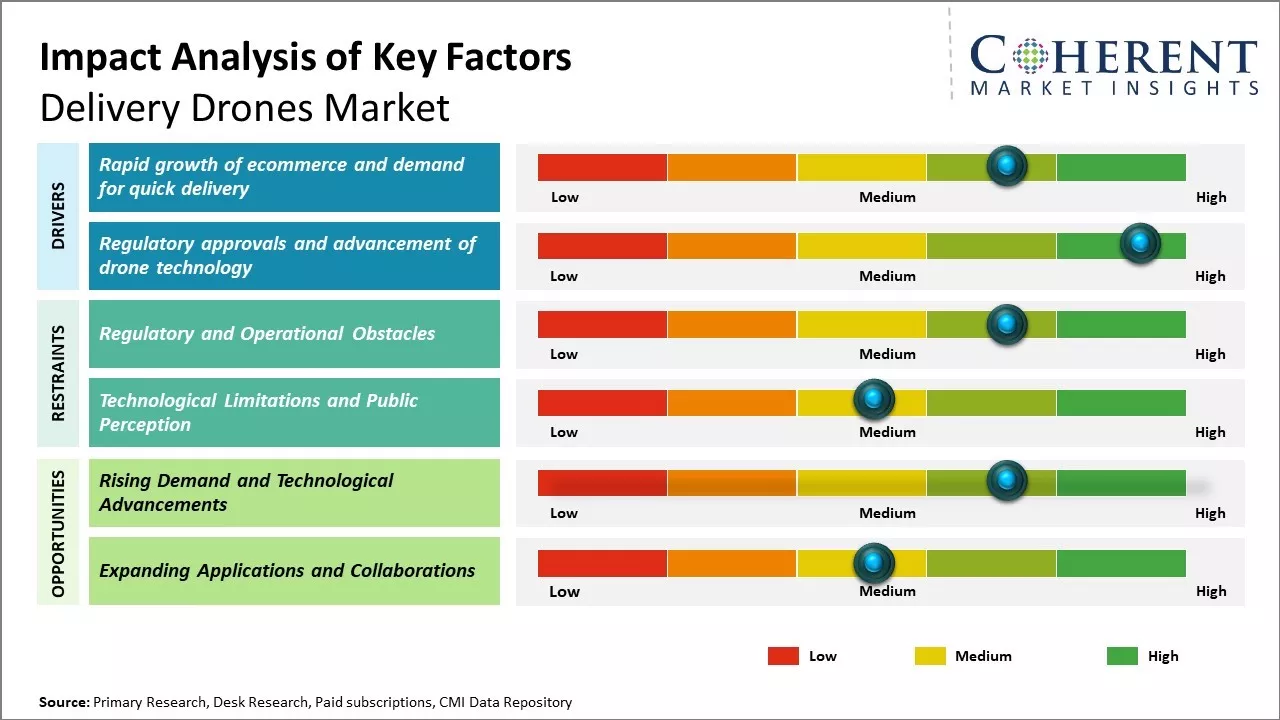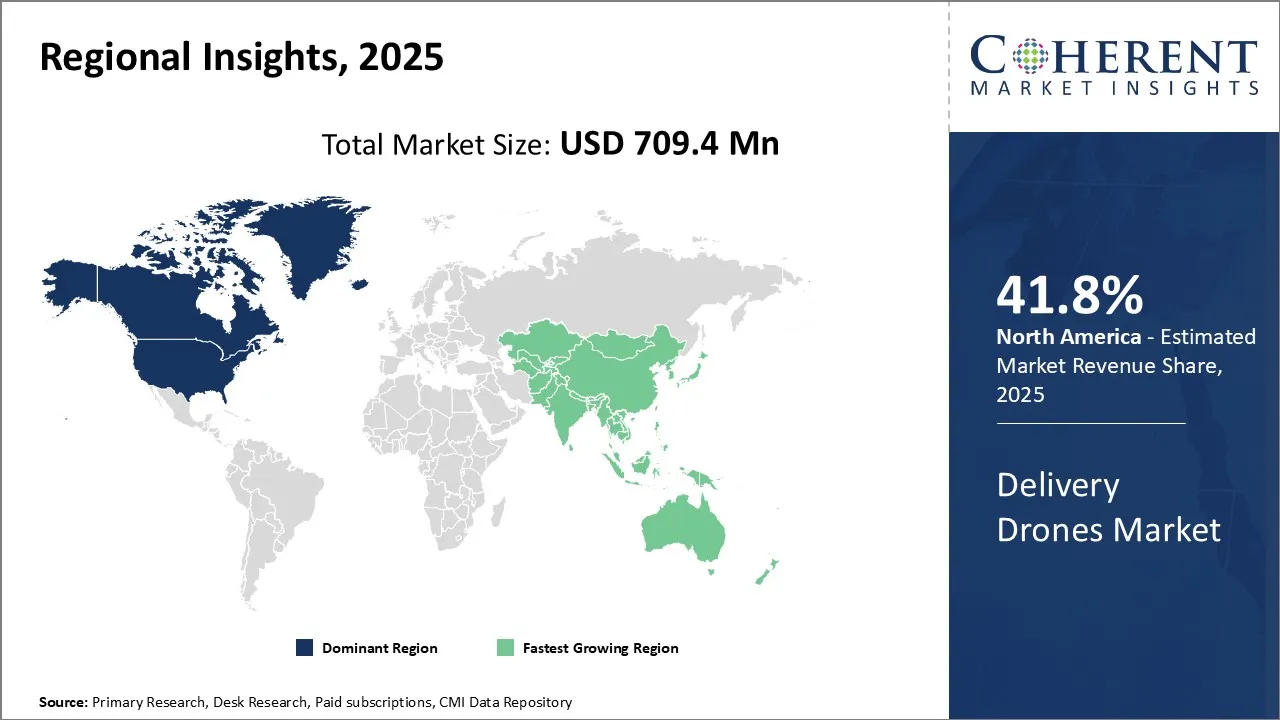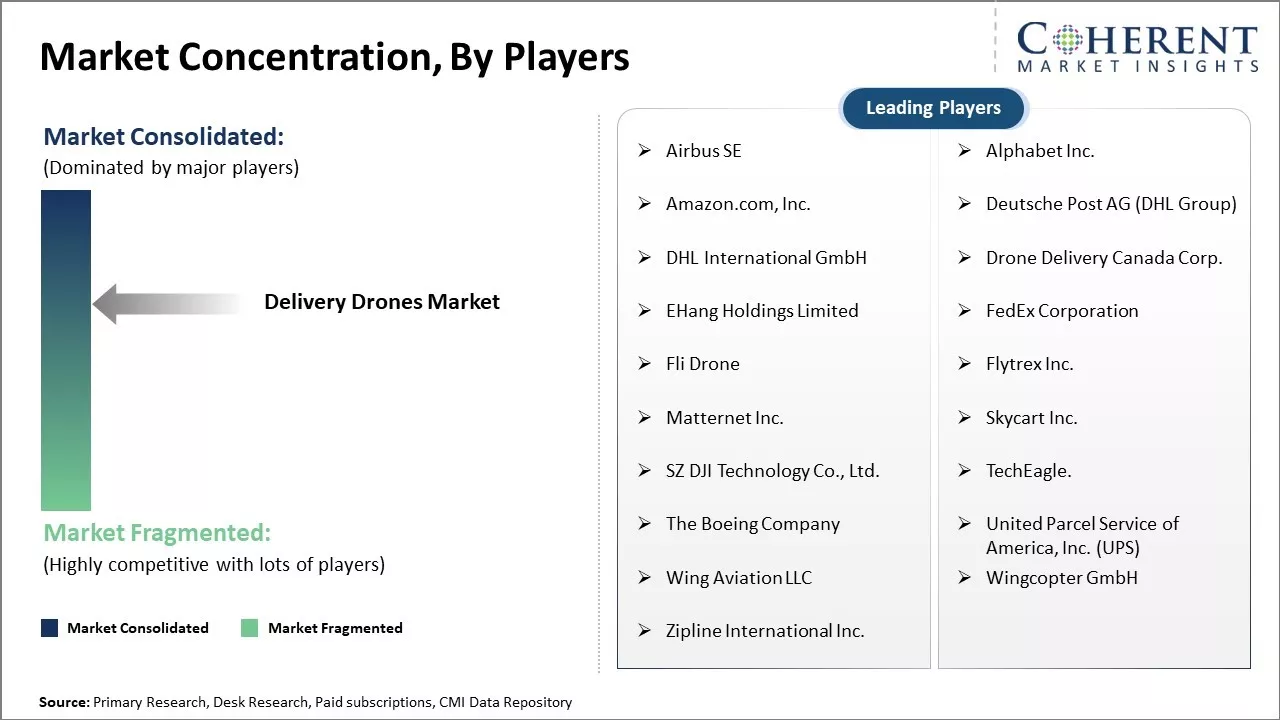The delivery drones market is estimated to be valued at USD 709.4 Mn in 2025 and is expected to reach USD 8,552.6 Mn by 2032, exhibiting a compound annual growth rate (CAGR) of 42.7% from 2025 to 2032.

To learn more about this report, Download Free Sample
This growth is driven by the expanding e-commerce and logistics industry worldwide along with advancements in drone technology which is enhancing their delivery carrying capacity and flight duration. The delivery drones market is expected to witness significant growth over the forecast period. Regulatory norms are being amended to allow for the commercial use of drones for delivery purposes. Several companies are investing in research and development to introduce improved delivery drones with VTOL capability, autonomous navigation, and advanced battery technology enabling longer flight times. Drone delivery is emerging as a cost-effective method for last mile deliveries for retail, food, and logistics companies.
|
Current Event |
Description and its Impact |
|
Regulatory Framework Evolution and Airspace Integration |
|
|
Supply Chain Disruptions and Last-Mile Delivery Challenges |
|
Uncover macros and micros vetted on 75+ parameters: Get instant access to report
In terms of drone type, multi-rotor wing is expected to contribute the highest share of 47.7% in 2025, due to their versatility, ease of use, and cost-effectiveness. These drones are particularly well-suited for short-range deliveries in urban and suburban environments, where maneuverability and vertical take-off and landing (VTOL) capabilities are crucial. Their ability to hover and navigate tight spaces makes them ideal for last-mile delivery applications such as food, retail, and medical supplies. Additionally, the relatively low maintenance and operational costs of multi-rotor drones have made them the go-to choice for startups and established logistics companies alike. While fixed-wing and hybrid drones offer advantages in range and speed, their higher costs and complex infrastructure requirements limit their widespread adoption compared to multi-rotor models.
For instance, in May 2025, the Royal Netherlands Aerospace Centre launched the Quick Response Drone Facility (QRDF) to accelerate drone innovation for defense applications. In collaboration with the Dutch Ministry of Defence, the initiative includes a fleet of four multi-rotor and one fixed-wing drone, supporting rapid deployment and operational testing under the SYNERGY project.
In terms of component, hardware is expected to contribute the highest share of 66.9% in 2025. This segment encompasses the physical parts of the drone, including airframes, propulsion systems, batteries, sensors, and navigation units. These components represent the bulk of the investment in drone manufacturing and deployment, especially as companies strive to enhance payload capacity, flight stability, and energy efficiency. The demand for advanced sensors and high-performance batteries has surged, driven by the need for longer flight times and safer autonomous operations. While software and services are growing rapidly, particularly in areas like route optimization and fleet management, the hardware segment continues to lead in terms of revenue due to its foundational role in drone functionality.
For instance, in July 2025, a startup in Tiruchi showcased a large cargo drone capable of delivering goods during a demonstration at a local school. The drone, designed for heavy payloads, highlights advancements in drone hardware and logistics technology. Students and faculty witnessed the potential of aerial delivery systems, signaling growing interest in drone-based solutions for transportation and supply chain efficiency.
In terms of End Use Industry, the food delivery segment is expected to capture the largest share of the market in 2025, driven by rising consumer expectations for fast, contactless, and convenient meal services. Major players such as Uber Eats, Zomato, and Domino’s have significantly expanded their drone logistics capabilities, capitalizing on the efficiency and speed drones offer in urban environments. These aerial systems help bypass traffic congestion and reduce delivery times, making them ideal for densely populated areas. Regulatory support in several countries has enabled pilot programs and commercial deployments, further solidifying food delivery as the most mature and commercially viable application of drone technology. While other sectors like medical aid and retail goods delivery are gaining traction, food delivery continues to lead in adoption and market share.
For instance, in August 2025, GoTo Foods, in partnership with DoorDash and Wing, launched drone-based food delivery in Plano, Frisco, and Fort Worth, Texas. The initiative uses Wing’s autonomous drones to deliver meals from brands like Jimmy John’s, marking a significant step in integrating aerial logistics into mainstream food service and enhancing delivery speed and convenience.

To learn more about this report, Download Free Sample
North America has established itself as the clear leader in the delivery drones market. The region is expected to account for a market share of 41.8% in 2025. The region hosts major drone manufacturers and innovators, especially in the U.S., where startup activity and commercialization of unmanned aerial vehicles thrive. Progressive regulations, including BVLOS approvals in several states, have enabled early testing and deployment. Companies have successfully piloted drone deliveries for healthcare, retail, and food services. This blend of technological leadership, favorable policies, and rapid adoption gives North America a significant edge over other regions in shaping the future of drone logistics.
For instance, in August 2025, Walmart expanded its ultra-fast drone delivery service across the U.S., aiming to reach millions of households. Partnering with drone companies, the retail giant now offers rapid aerial delivery of groceries and essentials in select states. This move strengthens Walmart’s logistics capabilities and highlights growing consumer demand for faster, tech-driven shopping experiences.
Asia Pacific has emerged as the fastest growing regional market for delivery drones over the forecast period, driven by vast populations, remote communities, and rising demand for rapid e-commerce logistics. Countries like China and India offer significant opportunities for drone-based delivery due to geographic and demographic diversity. Economic growth has fueled online shopping, while governments across the region actively support commercial drone programs. Notably, China and Singapore have introduced pioneering BVLOS regulations, enabling advanced operations. These favorable conditions, combined with early adoption efforts, position Asia Pacific to surpass other regions in drone usage and innovation over the coming years.
For instance, in September 2025, the Hong Kong Hospital Authority launched a pilot program using drones to deliver medicine between Cyberport and St John Hospital in Cheung Chau. Partnering with SF Express, the initiative cuts delivery time from over 45 minutes to just 20. It’s part of Hong Kong’s push to expand drone use in healthcare and logistics.
The U.S. delivery drones market is booming in 2025 due to strong tech innovation, supportive BVLOS regulations, and widespread adoption by major players like Amazon and Walmart. High consumer demand for fast, contactless delivery and successful pilot programs across healthcare, retail, and food sectors further fuel growth, making the U.S. a global leader in drone logistics.
For instance, in September 2025, Uber partnered with Flytrex to launch a drone delivery service in the U.S., expanding its logistics capabilities. The collaboration aims to offer faster, contactless delivery of food and retail items using autonomous drones. This move marks Uber’s latest step in embracing aerial technology to enhance convenience and efficiency in last-mile delivery solutions.
China’s delivery drone market is booming in 2025 due to rapid e-commerce growth, vast geographic coverage, and strong government support. Major logistics firms are deploying drones to cut last-mile delivery times, while regulators enable BVLOS operations through sandbox programs and UAV corridors. Technological advances like AI navigation and precision drops further drive demand.
For instance, in August 2025, Hangzhou launched its first regular drone delivery route, connecting Xiaoshan and Fuyang districts. Operated by Antwork, the service uses autonomous drones to transport medical and commercial goods, reducing delivery times and boosting logistics efficiency. This milestone marks a major step in integrating drone technology into urban transportation and supply chain infrastructure in China.
| Report Coverage | Details | ||
|---|---|---|---|
| Base Year: | 2024 | Market Size in 2025: | USD 709.4 Mn |
| Historical Data for: | 2020 To 2024 | Forecast Period: | 2025 To 2032 |
| Forecast Period 2025 to 2032 CAGR: | 42.7% | 2032 Value Projection: | USD 8,552.6 Mn |
| Geographies covered: |
|
||
| Segments covered: |
|
||
| Companies covered: |
Airbus SE, Alphabet Inc., Amazon.com, Inc., Deutsche Post AG (DHL Group), DHL International GmbH, Drone Delivery Canada Corp., EHang Holdings Limited, FedEx Corporation, Fli Drone, Flytrex Inc., Matternet Inc., Skycart Inc., SZ DJI Technology Co., Ltd., TechEagle., The Boeing Company, United Parcel Service of America, Inc. (UPS), Wing Aviation LLC, Wingcopter GmbH, and Zipline International Inc. |
||
| Growth Drivers: |
|
||
| Restraints & Challenges: |
|
||
Uncover macros and micros vetted on 75+ parameters: Get instant access to report
With the ever-increasing popularity of online shopping, the demand for quick and convenient delivery of items purchased online has also been rising rapidly. Many e-commerce retailers and food delivery companies are constantly looking for innovative ways to cut down delivery times and provide a superior delivery experience to their customers. Traditional delivery methods that rely on road transport can often get slowed down due to traffic congestion in urban areas. This is where drone delivery seems to provide a very attractive alternative as drones have the capability to take the aerial route and avoid traffic bottlenecks on the ground. Drones can reach locations much faster than ground vehicles in many cases, significantly boosting efficiency and contributing to the growing delivery drones market share worldwide.

To learn more about this report, Download Free Sample
While delivery drones seem like a promising solution, stringent regulations around their use were limiting the growth of this industry until recently. However, many countries and local aviation authorities are now slowly easing restrictions and providing more approvals and guidelines for commercial drone operations within their territories. They recognize the benefits that drones can bring for last-mile delivery especially in remote and inaccessible locations. As regulations continue to be relaxed in phases with safety measures, it will help boost the adoption of drones among delivery companies. Moreover, ongoing research and development is helping drone technology to advance rapidly with innovations making drones safer, more reliable and capable of carrying heavier payloads over longer distances, contributing significantly to the rising delivery drones market value.
The delivery drones market forecast indicates robust growth driven by rising demand and rapid technological advancements. Increasing e-commerce activity and consumer expectations for faster, contactless delivery are fueling adoption across sectors. Innovations in AI, GPS navigation, and battery efficiency are enhancing drone capabilities, enabling longer flight times and precise drop-offs. Regulatory support and pilot programs by logistics giants further validate market potential. As urban congestion and sustainability concerns grow, drones offer a scalable, eco-friendly alternative. With expanding applications in healthcare, retail, and food delivery, the delivery drones market is poised for transformative impact and exponential expansion over the coming years.
The delivery drones market is evolving into a specialized logistics enabler rather than a universal delivery solution. Operational maturity is visible in high-density, mission-specific use cases such as medical logistics and industrial campus deliveries. Zipline, for instance, has surpassed 1 million deliveries and 100 million autonomous miles, while Alphabet’s Wing completes over 1,000 deliveries per day in select regions, proving commercial viability where routes are repetitive and regulated.
Regulation remains the decisive factor shaping scalability. FAA Part 135 certification, achieved by UPS Flight Forward and others, acts as a regulatory moat, restricting large-scale expansion to compliant operators. However, safety concerns, including ongoing probes into Amazon Prime Air incidents, underscore that urban-scale operations still face public and technical scrutiny.
Sustained growth will rely on predictable demand density, high-value or time-critical payloads, and local regulatory cooperation. Investment should prioritize operational control systems, certified maintenance chains, and sense-and-avoid technologies rather than fleet expansion alone. Over-optimistic projections of mass consumer drone delivery remain detached from regulatory and infrastructural realities.
Definition: The delivery drones market consists of companies manufacturing drones dedicated for delivery purposes. These drones are designed to autonomously transport packages, food orders, medicines and other goods to customers within a limited range. Generally powered by electric motors, delivery drones use GPS and other sensors for navigation. They aim to make deliveries faster and more cost-effective than traditional delivery methods. The market has grown recently due to the rise in e-commerce and demand for quick deliveries of online orders straight to customers' doors.
Share
Share
About Author
Ameya Thakkar is a seasoned management consultant with 9+ years of experience optimizing operations and driving growth for companies in the automotive and transportation sector. As a senior consultant at CMI, Ameya has led strategic initiatives that have delivered over $50M in cost savings and revenue gains for clients. Ameya specializes in supply chain optimization, process re-engineering, and identification of deep revenue pockets. He has deep expertise in the automotive industry, having worked with major OEMs and suppliers on complex challenges such as supplier analysis, demand analysis, competitive analysis, and Industry 4.0 implementation.
Missing comfort of reading report in your local language? Find your preferred language :
Transform your Strategy with Exclusive Trending Reports :
Frequently Asked Questions
Joining thousands of companies around the world committed to making the Excellent Business Solutions.
View All Our Clients